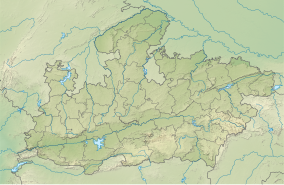Pench National Park
This article needs additional citations for verification. (June 2016) |
| Pench National Park | |
|---|---|
| Indira Priyadarshni National Park | |
 Landscape in Pench National Park | |
| Location | |
| Nearest city | Seoni |
| Coordinates | 21°40′17.76″N 79°18′11.88″E / 21.6716000°N 79.3033000°E |
| Area | 758 km2 (293 sq mi)[1] |
| Established |
|
| Governing body | State Forest Department |
| Website | penchnationalpark.com |
Pench National Park is a national park in the Indian state of Madhya Pradesh and Maharashtra. It is part of Pench Tiger Reserve and covers an area of 758 km2 (293 sq mi). It was declared a sanctuary in 1965, raised to the status of a national park in 1975 and enlisted as a tigers reserve in 1992. The national park consists of dry deciduous forests; fauna includes tiger, deer and birds.[2][3][4]
Geography
[edit]Pench National Park is located in Seoni District and chhindwara district of Madhya Pradesh and Nagpur district of Maharashtra. It comprises 758 km2 (293 sq mi), of which 299 km2 (115 sq mi) form the park's core area and Mowgli Pench Sanctuary. The remaining 464 km2 (179 sq mi) form the buffer zone. Around 257 square kilometres area is in Maharashtra.[5] It derives its name from the Pench River that flows through the park. It's elevation ranges from 425 to 620 m (1,394 to 2,034 ft). The protected area is covered with small hills and teak mixed forest in the southern reaches of the Satpura Range. The temperature varies from 4 °C (39 °F) in December to 42 °C (108 °F) in May. Average rainfall is 1,300 mm (51 in).[3]
Vegetation
[edit]The forest in the park consists of dry deciduous forests and tree includes teak mixed with other species like saja, bijiayasal, lendia, haldu, dhaora, salai, amla, amaltas, mahua and white kulu. The ground is covered with maze of grasses, plants, bushes and saplings. Bamboo is also found at places.[3]
Wildlife
[edit]The Pench National park is home to diverse flora and fauna which includes over 40 species of mammals, 13 species of reptiles and more than 210 bird species.[2] It host snake species such as cobras, pythons and the Indian krait.[5]
Mammals
[edit]

Pench National Park hosts Bengal tiger, Indian leopard, Indian wolf, chital, sambar, barking deer, four-horned antelope, gaur, nilgai, wild boar, golden jackal, fox, striped hyena, sloth bear, dhole, porcupine, Semnopithecus entellus, Rhesus monkey and jungle cat.[2][5]
Birds
[edit]
It is also harbours more than 210 bird species including several migratory ones. Some of them are Indian peafowl, junglefowl, Indian vulture, crow pheasant, crimson-breasted barbet, red-vented bulbul, racket-tailed drongo, Crested serpent eagle, Nisaetus cirrhatus, Indian roller, magpie robin, lesser whistling teal, pintail, shoveller, egret and herons, minivet, oriole, wagtail, munia, myna, waterfowl and common kingfisher.[4][5]
In culture
[edit]Pench National Park is one of many places that may have inspired Rudyard Kipling's The Jungle Book.[6]
The forest reserve has also provided location for the BBC wildlife series Tiger: Spy in the Jungle, a three-part documentary narrated by David Attenborough.[7]
References
[edit]- ^ World Database on Protected Areas (2019). "Pench National Park". Protected Planet.
- ^ a b c "6 reasons why Pench National Park is such a hit among wildlife lovers". Times of India. 6 January 2025. Retrieved 8 January 2025.
- ^ a b c "Crouching tiger at hidden Rukhad". New Indian Express. 15 July 2024. Retrieved 9 January 2025.
- ^ a b "Birds of Pench". Inditales. 2016. Retrieved 5 March 2019.
- ^ a b c d "Apart from the big cat, the Pench Tiger Reserve in Madhya Pradesh flaunts a variety of fabulous residents". Business Insider. 7 March 2021. Retrieved 8 January 2025.
- ^ Andres, T. (2016). "The Jungle Book: 5 best tours to Rudyard Kipling's India". The Telegraph. Retrieved 11 December 2017.
- ^ Sharanya Hrishikesh (18 January 2022). "Collarwali: Remembering India's 'super mum' tigress". BBC News. Retrieved 8 January 2025.



